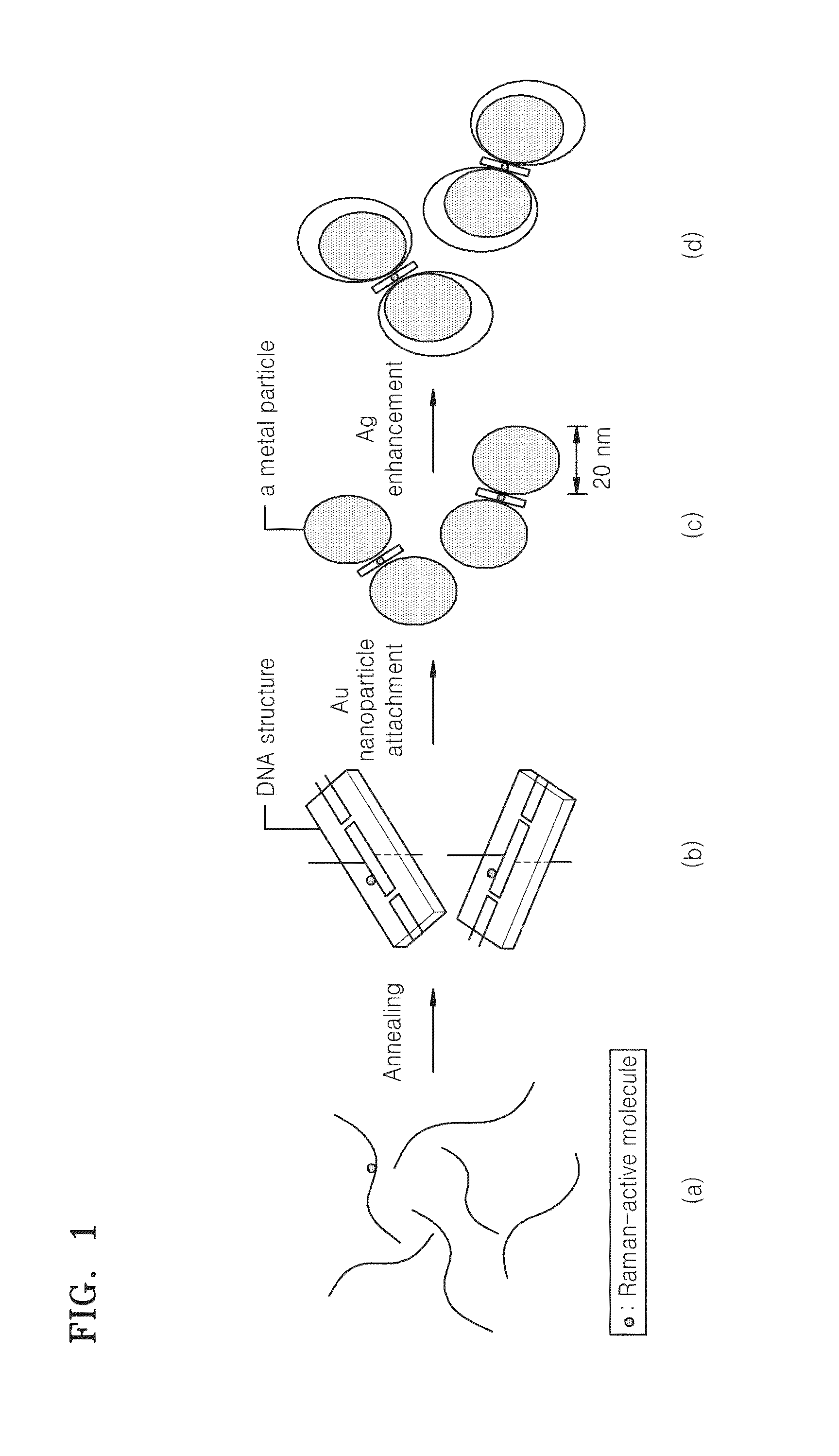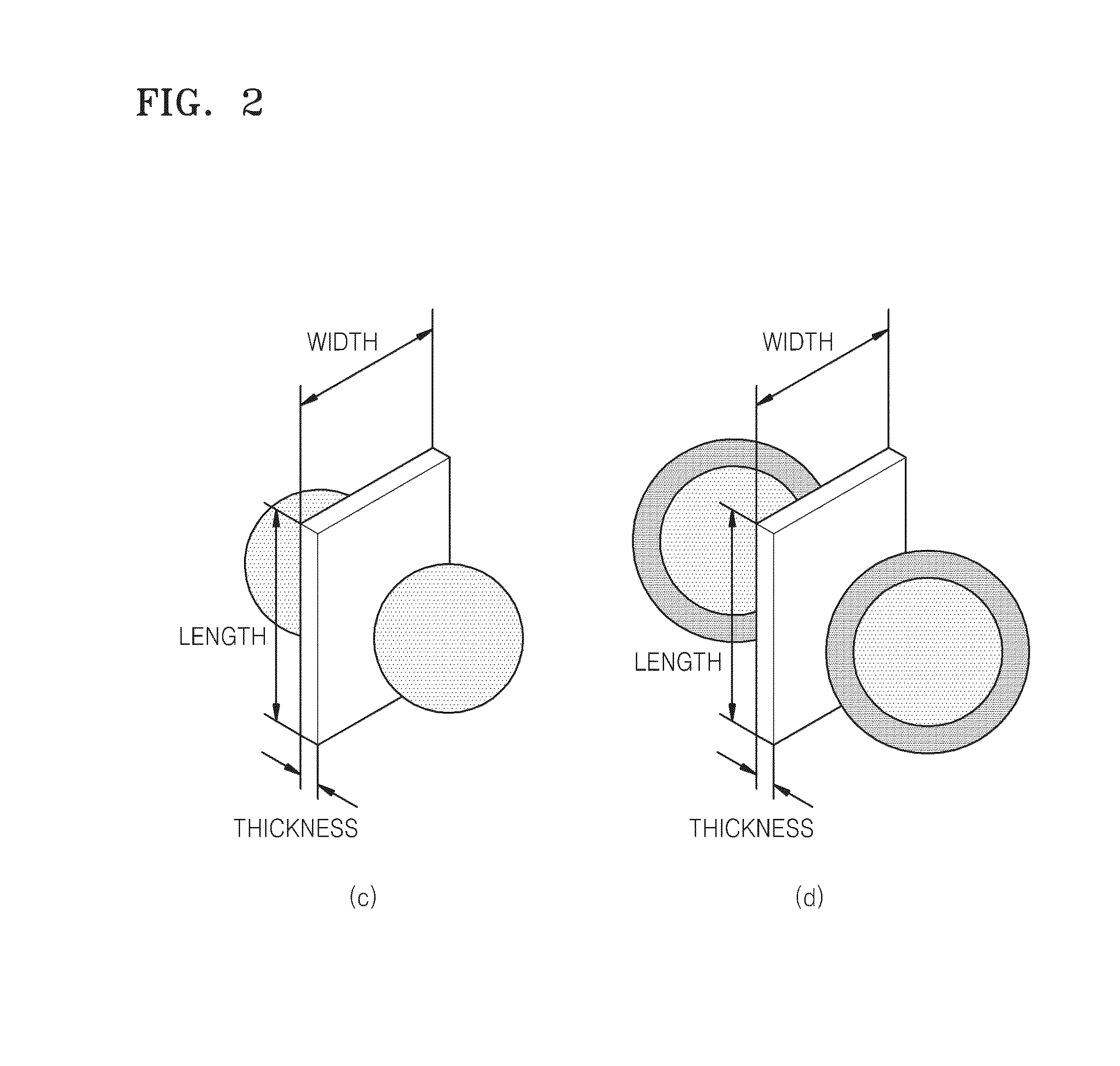Interparticle spacing material including nucleic acid structures and use thereof
a technology of interparticle spacing and nucleic acid, which is applied in the field of interparticle spacing material including nucleic acid structures, can solve the problems of low signal intensity, poor reproducibility, and not yet commercialized version of raman spectroscopy
- Summary
- Abstract
- Description
- Claims
- Application Information
AI Technical Summary
Benefits of technology
Problems solved by technology
Method used
Image
Examples
example 1
Synthesis of DNA Nanostructures
[0060]DNA nanostructures with a double crossover were synthesized via self-assembly of 6 DNA sequences (see E. Winfree, F. Liu, L. A. Wenzler, N. C. Seeman, Nature 1998, 394, 539-544). DNA was adjusted to a final concentration of 100 nM using 1× TBE / NaCl buffer. Each of the DNA nanostructures used as a template for amplification was heated to 95° C. for annealing, and then slowly cooled down to room temperature. The resulting DNA nanostructures synthesized via self-assembly were tile arrays with double-crossover nucleic acid.
[0061]FIG. 3 shows a diagram illustrating a nucleic acid sequence designed for manufacturing a DNA structure according to an exemplary embodiment of the present invention. As shown in FIG. 3, DNA nanostructures consist of two neighboring double stranded DNA which are connected by two crossover junctions. In the two crossover junctions there are 21 nucleotides which make two complete turns of about 720°. The thus obtained DNA nanost...
example 2
Binding between DNA Nanostructures and Au Particles
[0063]A solution including the DNA nanostructures prepared in Example 1 and a TCEP solution were mixed in 1× TBE, 50 mM NaCl in a 1:5 volume ratio, and incubated for 1 hour to obtain sulfur-modified DNA strands.
[0064]In order to modify the surface of Au nanoparticles, the citrate-coated Au nanoparticles were treated with bis(p-sulfonatophenyl)phenylphosphine dihydrate dipotassium (BSPP) as follows. 40 mg of BSPP was added to Au nanoparticles coated with 100 mL of citrate and allowed to react overnight. Then, solid NaCl was slowly added to the reaction mixture until the mixture changed from blue to bright blue. The mixture was centrifuged at 3000 rpm for 30 min, and the resulting supernatant was discarded. The Au nanoparticle pellets were washed with 1 ml of methanol, then resuspended in 1 ml of 2.5 mM BSPP solution, and then the optical density of the Au nanoparticle pellets was measured at about 520 nm and quantitated.
[0065]TCEP-tr...
example 3
Ag Coating on Au Particles
[0067]AgE / Au-DNA nanostructures, i.e., Au-DNA nanostructures where Ag is enhanced on the surface of Au particles, were obtained as follows. A solution containing 50 μl of dimeric Au-DNA nanostructures was allowed to react with 10 μl of 1 mM AgNO3 overnight in the presence of 20 μl of 1% poly-vinyl-2-pyrrolidone as a stabilizer and 10 μl of 0.1 M L-sodium ascorbate as a reducing agent. The resultant was dissolved in 0.3 M PBS. The material obtained therefrom was observed under TEM, UV-VIS, and EDS, respectively.
[0068]FIG. 8 shows a transmission electron microscopy (TEM) image of AgE / Au-DNA according to an exemplary embodiment of the present invention. As shown in FIGS. 8(a) and (b), the average size of the Ag-enhanced Au nanoparticles (AgE / Au) was about 49 nm. Furthermore, the distance between the surfaces of the two metal particles was not changed even after the Ag-enhancement due to the rigid two-dimensional DNA nanostructures disposed between the Au nanop...
PUM
| Property | Measurement | Unit |
|---|---|---|
| size | aaaaa | aaaaa |
| size | aaaaa | aaaaa |
| size | aaaaa | aaaaa |
Abstract
Description
Claims
Application Information
 Login to View More
Login to View More - R&D
- Intellectual Property
- Life Sciences
- Materials
- Tech Scout
- Unparalleled Data Quality
- Higher Quality Content
- 60% Fewer Hallucinations
Browse by: Latest US Patents, China's latest patents, Technical Efficacy Thesaurus, Application Domain, Technology Topic, Popular Technical Reports.
© 2025 PatSnap. All rights reserved.Legal|Privacy policy|Modern Slavery Act Transparency Statement|Sitemap|About US| Contact US: help@patsnap.com



